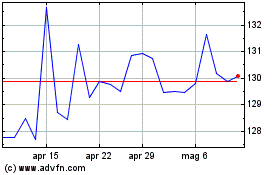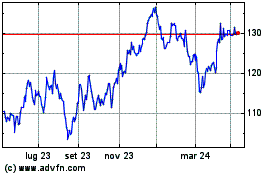Rio Tinto: China Covid Curbs Weighed More on Steel Demand Than Output -- Commodity Comment
15 Luglio 2022 - 2:26AM
Dow Jones News
Rio Tinto PLC on Friday reported a lift in second-quarter
production of iron ore, copper and bauxite, but downgraded
full-year guidance for aluminum, alumina and diamonds. Here are
some remarks from its quarterly operations report.
On iron-ore production:
"Gudai-Darri delivered first ore from the main plant in June. As
it ramps up, we expect increased production volumes and improved
product mix in the second half, with Gudai-Darri capacity to be
reached in 2023. Pilbara operations produced 78.6 million [metric]
tons (100% basis) in the second quarter, 4% higher than the second
quarter of 2021. While significantly higher than average rainfall
in May impacted mine production, continued focus on mine pit health
and commissioning of Gudai-Darri supported a stronger second
quarter."
On iron-ore markets:
"Iron ore Platts CFR prices trended downwards to $120/ton at the
end of the second quarter, even though the average prices were just
below $140/ton year to date. The downward pressure was driven by
extended Covid-19 restrictions that impacted China's downstream
steel demand to a greater extent than steel production and iron ore
consumption."
On aluminum output:
"Aluminum production [of 731,000 tons] was 10% lower than the
second quarter of 2021 due to reduced capacity at our Kitimat
smelter in British Columbia following the strike which commenced in
July 2021. A controlled restart began at the end of the second
quarter of 2022, with ramp-up progressing subject to plant
stability. Production at Boyne smelter in Queensland was impacted
due to process instability following COVID-19 related unplanned
absences. Production has been stabilized and the cells that have
been taken offline are being ramped up over the next 12 months. All
of our other smelters continued to have stable performance."
On aluminum markets:
"Following record high prices in the first quarter, the expected
disruption to Russian aluminum production did not materialize.
Strong aluminum supply and weaker domestic demand in China shifted
it to a net export position for aluminum in the first half of 2022.
Alumina shifted to a net export position over the same period due
to strong growth in domestic refining. The outlook for demand
growth has also been dampened by Covid-19 restrictions in China and
the reduced consumer sentiment in developed markets. Nevertheless,
reported inventories continue to decline and high power prices are
limiting production growth outside China."
On copper output:
"Mined copper production of 126,000 tons was 9% higher than the
second quarter of 2021 due to higher material movement and higher
grades and recoveries at Kennecott and Escondida, partly offset by
lower grades and recoveries at Oyu Tolgoi as a result of planned
mine sequencing."
On copper markets:
"After reaching a record quarterly average price in the first
quarter, prices started trending down in late April, as a wave of
uncertainty surrounding the global economy and China's Covid-zero
policy weighed on the prospects for copper demand. Exchange
inventories remain at multi-year lows, and mine supply continues to
face disruptions, although mine project start-ups in the second
half should help alleviate market tightness."
On lithium markets:
"The electric-vehicle market continues to enjoy firm growth,
despite rising raw material costs and general supply chain issues
in the automotive market. After sharp price increases in the
previous quarters, lithium carbonate prices stabilized in the
second quarter, as supply starts to keep pace with demand. Mine
supply growth is expected to pick up further in the second half as
idled mine capacity and new projects come online."
Write to Rhiannon Hoyle at rhiannon.hoyle@wsj.com
(END) Dow Jones Newswires
July 14, 2022 20:11 ET (00:11 GMT)
Copyright (c) 2022 Dow Jones & Company, Inc.
Grafico Azioni Rio Tinto (ASX:RIO)
Storico
Da Mar 2024 a Apr 2024

Grafico Azioni Rio Tinto (ASX:RIO)
Storico
Da Apr 2023 a Apr 2024
